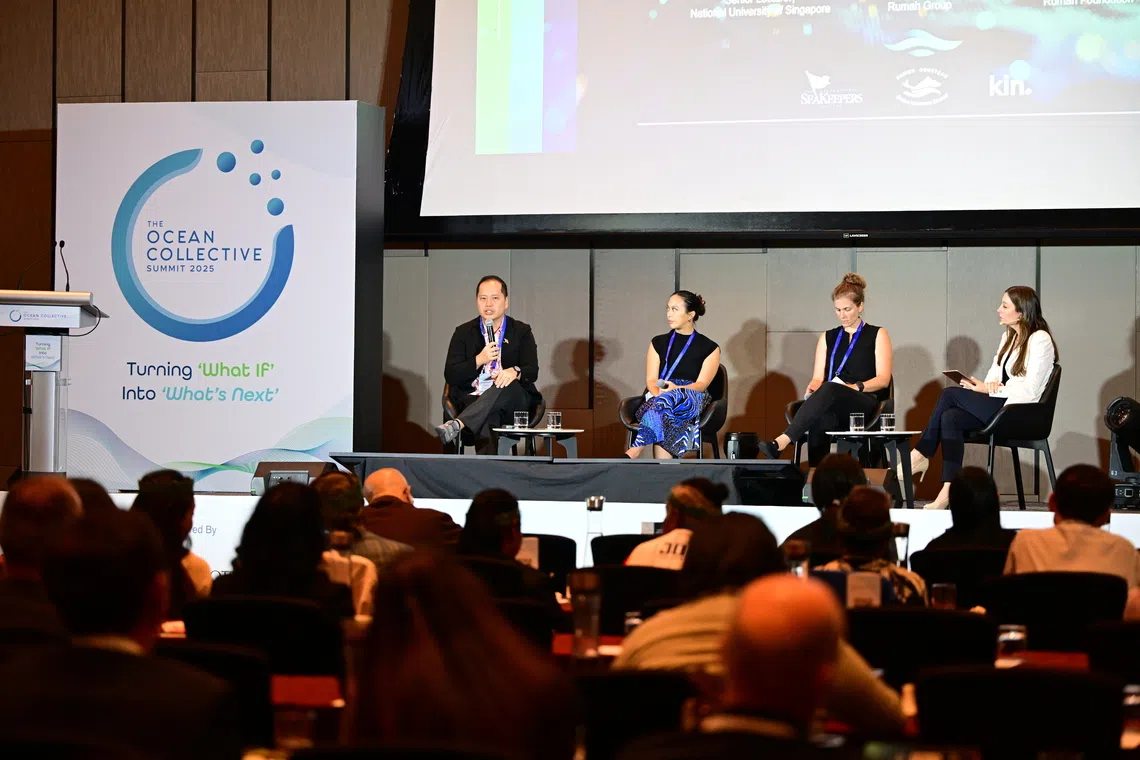Only 1% of philanthropic funding goes to ocean conservation projects: panellist
NUS senior lecturer says this is despite about 70% of the world’s surface being covered by ocean

[SINGAPORE] There is a gap in ocean conservation funding and it needs to be addressed, said Dr Toh Tai Chong, a marine biologist, at the Ocean Collective Summit held from Oct 2 to 3.
Dr Toh, who is also a senior lecturer at the National University of Singapore, was speaking at the panel discussion, and mentioned that in 2022, ocean funding was around US$1 billion. However, this only represents about 1 per cent of global philanthropic funds.
A 2025 report, The Ocean Protection Gap: Assessing Progress toward the 30×30 Target, also stated that US$1.2 billion goes into marine protection, when US$15.8 billion is needed. “This is despite about 70 per cent of the world’s surface is covered by ocean,” Dr Toh said.
The study was launched in June this year by a consortium of nature NGOs (non-governmental organisations) and funders, which included Bloomberg Philanthropies and WWF.
“Most philanthropic funding goes to social causes because they resonate with the donor’s preferences and values. Social outcomes also tend to be more visible and emotive... This is unlike oceans, which present outcomes that are more abstract, less visible, and take longer to effect changes,” noted the senior lecturer.
In an interview with The Business Times, he added: “However, supporting marine protected areas, for example, can increase fish stocks and fisheries output that will contribute to social and economic outcomes. By strategically supporting coastal communities, businesses and family offices can achieve dual outcomes that benefit both nature and people.”
The challenge, Dr Toh said, is the lack of sustained funding in this sector, which creates hurdles for implementers to continue their projects. “Using financial vehicles like trust funds or endowments, the financial returns can provide implementers with sustained financial support for longer-term projects.”
Fellow panellist Kathlyn Tan, principal at Rumah Group, concurred and added: “(Hence), towards the end of last year, (we) managed to find partners to launch a funders collaborative.”
Called 30×30 Southeast Asia Ocean Fund, it involves other organisations such as Asia Community Foundation and Oceankind. Tan said that the fund aims to create, expand and strengthen protected and conserved areas in South-east Asia.
Dr Naomi Clark-Shen, science lead at Rumah Foundation, said that the fund prioritises local organisations over international ones, “to build up that local capacity in SEA”.
The initiative also has to be “working towards one of the goals above”, Dr Clark-Shen added.

Elaborating on the funding gap, Dr Toh said that it exists because resource-intensive activities continue to reduce the value that nature provides, and funding is needed to restore that value. “To address these gaps, businesses and organisations can examine their supply chain and incorporate sustainable practices to reduce their environmental impacts... Organisations can also fund projects related to ocean conservation, in areas such as research, education, and the establishment of protected areas to meet the 30x30 targets.
Ocean funding supports resource sustainability, which ensures that the businesses that depend on oceans (for example, fisheries, maritime logistics) remain sustainable, he added.
“For family offices, ocean conservation is integral to climate protection and human health.”
Rumah Group’s Tan said that to further gain funding, the Singapore-based family office has incorporated other investment approaches such as blended finance and impact investing.
Dr Toh of NUS added: “Impact investing has its merits, especially since it diversifies the funding sources for ocean conservation and it caters to different giving preferences. When complemented with catalytic funding or venture philanthropy, impact investing can scale early-stage ventures that have demonstrated benefits or have passed the proof-of-concept.
“But impact investing alone is not sufficient; other efforts, such as connections to related industries, are still needed to create sufficient market demand and offtakes to sustain the programmes.”
Decoding Asia newsletter: your guide to navigating Asia in a new global order. Sign up here to get Decoding Asia newsletter. Delivered to your inbox. Free.
Copyright SPH Media. All rights reserved.

